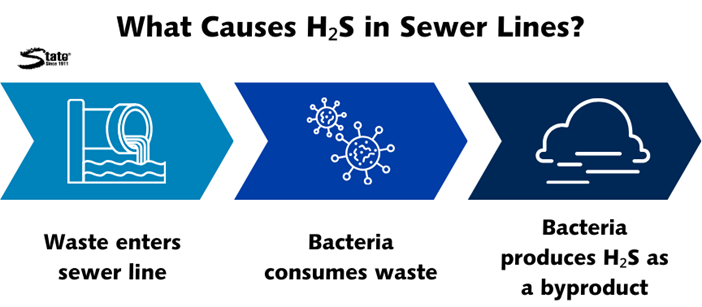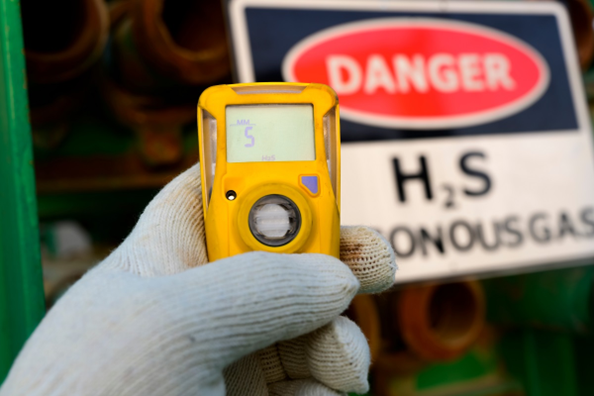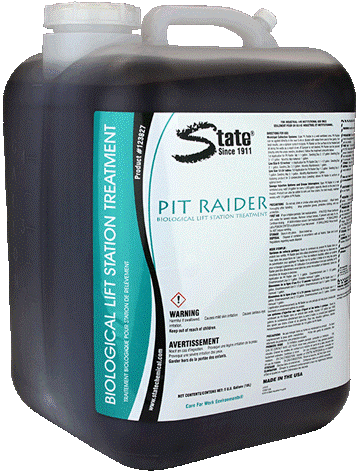What Causes H₂S in Sewers?
What Causes H₂S in Sewers?
The last thing you want are corroded sewer pipes full of toxic gases. Unfortunately, when hydrogen sulfide (H₂S) builds in your sewer system, this is the consequence you’re looking at. Even worse, H₂S is present in all sewers, and it’s impossible to completely eradicate. To fully understand how to handle the situation, you’ll want to know why this happens.
At State Chemical, we manufacture and distribute chemical solutions that address a variety of problems, including H₂S in sewer lines. When you’re suddenly dealing with this issue, it can be hard to get straight answers about the why, especially if you’re unfamiliar with scientific jargon. All in all, this can be frustrating when you just want to understand what’s happening.
To help you learn why H₂S is a problem, we will explain what H₂S is, what causes it to form in sewer lines, how this can affect wastewater collections, and how to treat it. After reading, you’ll know what causes H₂S and how to manage it.

What is H₂S Sewer Gas?
H₂S is a gas that naturally occurs in locations like sewers. With an odor of rotten eggs, H₂S is hazardous, flammable, and toxic. It can deteriorate concrete and corrode metal over time, and it’s dangerous to humans even at low levels.

Low-level exposure to H₂S gas can result in eye and throat irritation, headaches, nausea, dizziness, and coughing. However, high-level exposure can cause difficulty breathing, impaired motor ability, loss of consciousness, and even death. This is especially troubling since, in high quantities, H₂S paralyzes nerves, resulting in a loss of smell that renders H₂S virtually indetectable. The effects of H₂S also set in very quickly, making it crucial for facilities to be aware of the hazards and necessary safety protocols.
All this said, you can see why H₂S gas isn’t exactly desirable to encounter. But why does this occur in sewers, and what can you do about it?
What Causes H₂S to Form in Sewer Lines?
The formation of H₂S is caused by the natural bacterial breakdown of organics. Obviously, sewers by nature deal with a lot of organic waste. This is broken down by bacteria known as biofilm. After it’s broken down, H₂S is produced as a byproduct of the biofilm’s digestion.

As time goes on, this can produce high levels of H₂S. You may notice it by odors or visible corrosion/deterioration of lift stations and pipes or nearby areas.
Because sewers will always deal with waste, it’s impossible to completely curb H₂S production. After all, the more waste it sees, the larger the biofilm colony will grow and spread throughout the pipes. This just creates more and more H₂S, which can create problems if left unchecked.
Certain conditions will further promote H₂S production. For example, anaerobic conditions, a pH below 8, turbulent water flow, depletion of nitrates, an abundance of sulfates, warm wastewater, and slow wastewater flow can all trigger an influx of H₂S gas.
How Does H₂S Affect Wastewater Collections?
As previously explained, H₂S isn’t to be taken lightly. It has severe consequences, and your infrastructure will face them if you don’t take proper precautions to deal with H₂S.

More than anything, the health effects of H₂S can have serious impacts. Let’s say that your lift station is experiencing an issue, and you send someone into the system to deal with it. If H₂S levels are too high, this staff member could face severe health effects or even death as quickly as instantaneously. Refer to OSHA to learn more about compliance standards.
However, H₂S is also powerful enough to damage your sewer lines and associated equipment. The concrete deterioration and pipe corrosion it causes will necessitate more frequent repairs and replacements, which will be costly.
Overall, what initially presents as an annoying odor can build into a severe safety concern and financial burden.
What to Do About H₂S in the Sewer System
The impacts of H₂S aren’t ideal, but if it’s always going to be present, what can you really do about it?

Fortunately, there are both reactive and preventative approaches to H₂S treatment. These methods are proven to reduce H₂S gas and help make your wastewater collections system safer.
The most common method to reduce H₂S is through the use of calcium nitrate. You would need to continually dispense this product into your problem area, and it would feed the biofilm to satiate it. Once satiated, the biofilm no longer produces H₂S as a byproduct.
With this method, you would need to continually feed product into your sewer system and might eventually need to increase dosage in order to maintain effectiveness. This is considered a reactive approach but is an effective one nonetheless.
Your other option for reducing H₂S is to use bacterial products. In this approach, you would dispense “good” bacteria into your sewer system, and they would outcompete the H₂S-producing biofilm (also known as sulfate-reducing bacteria or SRB) for the same food source. This way, the “good” bacterial colony will continue to grow, pushing out the SRB and thus lowering the levels of H₂S. Bacterial products are generally considered a more effective long-term approach.
However, the most comprehensive treatment for H₂S is through the use of calcium nitrate and bacteria in tandem. Find the method that makes the most sense for you, and the reduction of H₂S will save you from potential health effects and repair costs.
Learn More About How to Reduce H₂S in Wastewater Collections
H₂S is a common presence and a shockingly harmful one. Now that you know what causes H₂S formation and how it can affect your wastewater collections system, read this article to learn more about how to reduce it.








